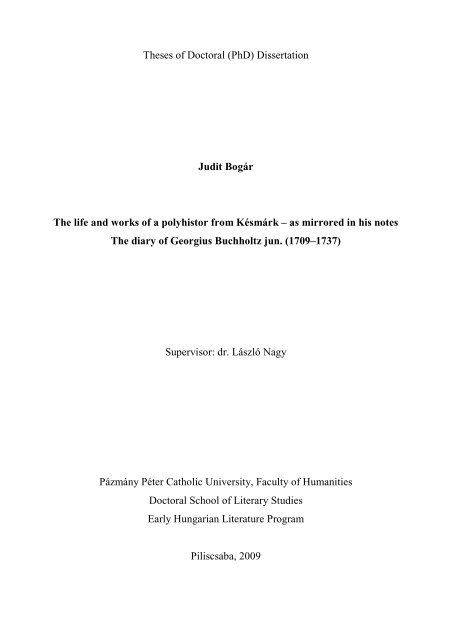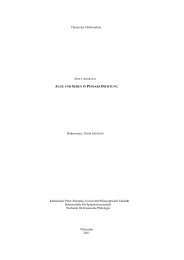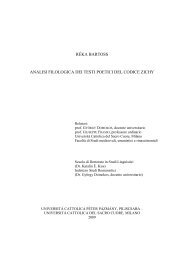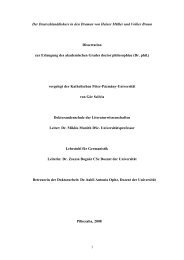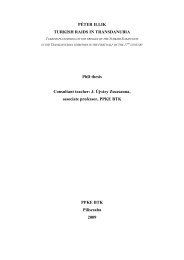tézisfüzet angol - Index of - Pázmány Péter Katolikus Egyetem
tézisfüzet angol - Index of - Pázmány Péter Katolikus Egyetem
tézisfüzet angol - Index of - Pázmány Péter Katolikus Egyetem
Create successful ePaper yourself
Turn your PDF publications into a flip-book with our unique Google optimized e-Paper software.
Theses <strong>of</strong> Doctoral (PhD) Dissertation<br />
Judit Bogár<br />
The life and works <strong>of</strong> a polyhistor from Késmárk – as mirrored in his notes<br />
The diary <strong>of</strong> Georgius Buchholtz jun. (1709–1737)<br />
Supervisor: dr. László Nagy<br />
<strong>Pázmány</strong> <strong>Péter</strong> Catholic University, Faculty <strong>of</strong> Humanities<br />
Doctoral School <strong>of</strong> Literary Studies<br />
Early Hungarian Literature Program<br />
Piliscsaba, 2009
I. Preliminaries to the research<br />
His contemporaries as well as literary and science historians <strong>of</strong> the 18–<br />
19th centuries considered Georgius Buchholtz jun. (1688–1737) as one <strong>of</strong> the<br />
most erudite people <strong>of</strong> his age, an outstanding scientist, preacher, teacher, and not<br />
least an excellent poet, however his name became almost totally forgotten by the<br />
second half <strong>of</strong> the 20th century. Buchholtz, born in Késmárk (today Kežmarok,<br />
Slovakia), noted day by day between 9th May 1709 and 25th July 1737 into his<br />
near 3000-pages-long diary what happened to him and in his environment, where<br />
he went, who he met, who he sent to and received from letters, what he read, what<br />
he wrote, what he taught at school, what he ate, what he bought, how he spent his<br />
free time. The manuscript, preserved in the Slovakian National Library (earlier<br />
Matica slovenská) in Turócszentmárton (today Martin, Slovakia; signature:<br />
C24/1–2), contains a great deal <strong>of</strong> information on everyday life, education, the<br />
Evangelical denomination, the world <strong>of</strong> science etc. The diary, forgotten for a<br />
long time, practically until now rested – apart from the examination <strong>of</strong> some<br />
smaller parts – unprocessed d unpublished. The aim <strong>of</strong> this dissertation is to<br />
analyse the diary, completing the information in it and the presentation <strong>of</strong> the<br />
author’s wide activity with data from other sources, manuscripts and printed<br />
material as well. The approach to the text is basically from cultural historical<br />
point <strong>of</strong> view, but I also examine it as a literary work.<br />
Studying the secondary literature one can find the name<br />
Georgius/György/Georg/Juraj Buchholtz jun. in many kinds <strong>of</strong> works. He is a<br />
constant character <strong>of</strong> biographical lexicons, histories <strong>of</strong> different branches <strong>of</strong><br />
science, church and school; most <strong>of</strong> the short references, however, contain quite a<br />
number <strong>of</strong> inaccuracies. The literature dealing directly with Buchholtz is less rich.<br />
At the beginning <strong>of</strong> the 20th century Samu Weber, Rudolf Weber, Johann Lipták<br />
did research on the family, especially the older and younger Georgius as<br />
preachers, teachers, scientists and explorers <strong>of</strong> the Tatra mountain. In the 1950–<br />
2
60s several studies were published about Georgius Buchholtz jun. within the<br />
frame <strong>of</strong> researches on history <strong>of</strong> German universities, which mostly treated his<br />
short stay in Halle and Jena on the basis <strong>of</strong> the text <strong>of</strong> his diary. The newer<br />
literature, written by Imre Varga, László Szelestei N., Ferenc Földesi (and me)<br />
deals primarily not with his person but his literary work.<br />
II. Methodological remarks<br />
To work up the whole diary – after examining some smaller parts – first<br />
I “excerpted” the text, that is I made a kind <strong>of</strong> database with the following<br />
headings: page number, date, topic, information, my remarks. The data in the<br />
chart is searchable and can be grouped according to different points <strong>of</strong> view.<br />
With knowledge <strong>of</strong> the content <strong>of</strong> the diary and Buchholtz’s life and<br />
activities, a basically cultural historical approach seemed the most fruitful out <strong>of</strong><br />
the different possibilities, this is how the colourfulness <strong>of</strong> the notes can be best<br />
shown. I examined the rich material in the diary by themes chosen according to<br />
the following points: what the author writes a lot about, in what fields the diary<br />
contains new information; main spheres <strong>of</strong> cultural history (peregrination,<br />
education, science, literature, reading etc.); biographical facts and events in<br />
connection with Buchholtz’s social status, pr<strong>of</strong>ession, denomination; typical diary<br />
subjects. To understand and evaluate the information in the diary and to put it into<br />
wider context I used not only secondary literature but also manuscripts and prints<br />
by Buchholtz and his contemporaries.<br />
The dissertation starts with an introduction containing reasons for the<br />
choice <strong>of</strong> subject, methodological remarks and a short survey <strong>of</strong> the literature on<br />
Buchholtz. It is followed by a summary <strong>of</strong> different theories on the genre <strong>of</strong> diary,<br />
then by Buchholtz’s biography. The main part <strong>of</strong> the dissertation deals with the<br />
processing <strong>of</strong> the data in the diary concerning the following topics:<br />
3
peregrinations, education and school life, Buchholtz’s literary works, his<br />
participation in the Hungarian and foreign world <strong>of</strong> science, correspondence<br />
(partly on the basis <strong>of</strong> his remained letters), reading, religion, everyday life. After<br />
the content analysis comes the examination <strong>of</strong> the author’s usage <strong>of</strong> languages<br />
and <strong>of</strong> his Hungarus-consciousness, then the study <strong>of</strong> the diary as a work <strong>of</strong> art. In<br />
the latter chapter I try to answer the questions to what extent Buchholtz’s diary<br />
suits the requirements <strong>of</strong> its genre, and whether it can be taken – and if yes, why –<br />
as a literary work. The appendix contains a chart <strong>of</strong> the structure <strong>of</strong> the diary<br />
(years, months and page numbers), the text <strong>of</strong> Hungarian poems in it, and the<br />
transcription <strong>of</strong> three letters written by Matthias Bél to Buchholtz, unknown so<br />
far.<br />
III. New results in the dissertation<br />
The abundance <strong>of</strong> the material and the limits <strong>of</strong> the dissertation’s extent,<br />
the great number and at the same time the unexploredness <strong>of</strong> other scripts by<br />
Buchholtz, the contradictions between the primary sources and the technical<br />
literature and in many cases the lack <strong>of</strong> them – they all take part in that the<br />
research cannot be regarded as completed. I tried to provide a comprehensive<br />
survey <strong>of</strong> the diary so I could not (but I did not really wanted, either, to) make an<br />
analysis <strong>of</strong> each themes with full particulars. Nevertheless, the examination<br />
brought important results: on the basis <strong>of</strong> the explored data many statements <strong>of</strong><br />
the technical literature can be completed or modified, and a great deal <strong>of</strong> new<br />
information concerning e. g. the history <strong>of</strong> peregrination, schools, education,<br />
scholarly life in Hungary and abroad at the beginning <strong>of</strong> the 18th century, the<br />
birth <strong>of</strong> literary works, well and less known people, not least Georgius Buchholtz<br />
himself came to light.<br />
4
Buchholtz’s diary is an acknowledged – for Greifswald a unique –<br />
source <strong>of</strong> German university life and education <strong>of</strong> his age. The parts about Halle<br />
and Jena have already been written about in German, the several hundred pages<br />
about Buchholtz’s stay in Greifswald have only been planned to publish for a<br />
long time by the local archive. At the beginning <strong>of</strong> the diary Buchholtz is<br />
relatively talkative so one can get a great deal <strong>of</strong> information on university<br />
education, subjects, curriculum, methods, disputations, student life, the early<br />
history <strong>of</strong> the scholarship that made the university <strong>of</strong> Greifswald so important for<br />
Hungarian students, and also on how a poor student sustains himself, how he<br />
rounds his small income from the scholarship, form his patrons and very rarely<br />
from home <strong>of</strong>f with teaching, paid work in writing and composing poems.<br />
Buchholtz’s dissertation has been known, now the circumstances <strong>of</strong> its birth came<br />
to light, too.<br />
The diary contains a lot <strong>of</strong> new information on Evangelical education.<br />
Very little has been known so far about the school in Nagypalugya (Veľká<br />
Paludza, Slovakia; not existing any more), from Buchholtz’s notes it becomes<br />
clear that he taught many kinds <strong>of</strong> pupil groups for many kinds <strong>of</strong> knowledge, on<br />
high level. Important contributions are the sample texts to the history <strong>of</strong> teaching<br />
<strong>of</strong> rhetoric, the greeting poems to the history <strong>of</strong> cantations, recorded in the diary.<br />
Since the Evangelicals had no uniform rules <strong>of</strong> education, any new data on certain<br />
schools widen our knowledge on this field. Therefore it is very important what<br />
from Buchholtz’s diary we get to know: besides the usual subjects concerning<br />
religion and Latin he taught history, geography, different branches <strong>of</strong> philosophy,<br />
physics, Greek and Hebrew, and he used teaching material made by himself as<br />
well as books by Dietericus, Matthias Bél, Comenius, Hedericus, Curtius, Weiss,<br />
Heunischius. From the remained laws <strong>of</strong> the secondary school in Késmárk we<br />
know quite a lot about that school, but Buchholtz’s diary is an important source<br />
<strong>of</strong> the application <strong>of</strong> the regulations in practice. New subjects compared to those<br />
in Nagypalugya are arithmetic, geometry, architecture, medicine, Hungarian,<br />
5
German, and some basic Polish, Syriac, French and Russian. He uses books by<br />
Vossius, Dietericus, König, Lange, Weiss, Wolff, Schrader, Curas and Hübner,<br />
and he uses newspapers as teaching material, too. One can get to know different<br />
events <strong>of</strong> the school year, the course <strong>of</strong> exams, excursions, punishments. The<br />
diary is an especially important source for school theatricals – a part <strong>of</strong> the data<br />
concerning this topic has already been known, but a more thorough examination<br />
<strong>of</strong> the text resulted in many additions and modifications to them.<br />
Georgius Buchholtz was considered an excellent poet by his<br />
contemporaries. He mentions the writing <strong>of</strong> nearly three hundred poems in his<br />
diary, and the text <strong>of</strong> more than one hundred <strong>of</strong> them can be read in it. From one-<br />
line chronostichs to several-pages-long greetings the poems are very different in<br />
length, genre and theme. Buchholtz mentions them by the following names:<br />
carmen, versus, rhythmus, cantilena, mnemonicus, versus Adonicus, epicaedium,<br />
chronostichon, epigramma, anagramma, cabbala, versus retrogradus, distichon,<br />
versus saphicus, epitaphium, epithalamium, sequentia, epigraphum, panegyricus,<br />
versus dactylicus, aenigma, leoninus, emblemata, versus onomasticus; and there<br />
is also an echo poem, a picture poem and a cisio in the diary. As for the topics,<br />
most <strong>of</strong> them are greetings for the new year, for someone’s birthday or name day,<br />
for weddings or funerals. Some <strong>of</strong> them are intended only for the addressee,<br />
others are read out publicly. He writes poems about his voyage from Danzig to<br />
Greifswald, the Swedish kings, chronostichs on his friends’ name and his<br />
mother’s death, a distich with chronostich on Luther, anagrams out <strong>of</strong> his friends’<br />
and acquaintances’ name, epitaphs for a dissected dog and a Martin-day goose.<br />
The texts are mostly in Latin, but there are some Hungarian and German ones<br />
among them. Some <strong>of</strong> his poems (mainly for weddings and funerals) were<br />
printed. He mentions several times that church songs by him were also published,<br />
but they are not known today. The transcription and examination <strong>of</strong> some <strong>of</strong> his<br />
poems in this dissertation widens our knowledge on occasional poetry <strong>of</strong> that age.<br />
6
Today Buchholtz’s name can be met first <strong>of</strong> all in works on science<br />
history. The technical literature mostly considers him as a colleague <strong>of</strong> Matthias<br />
Bél; from his diary it turns out what it means exactly, the steps <strong>of</strong> his work <strong>of</strong><br />
describing counties and caves can be followed. The notes reveal that Daniel<br />
Fischer intended to found not only a journal at around 1730 but presumably also a<br />
kind <strong>of</strong> scholarly society; and they also show (with some complements from<br />
letters) how Buchholtz helped Samuel Matthaeides in continuing Johannes<br />
Rezik’s Gymnasiologia, what kind <strong>of</strong> material he collected to it and how his<br />
students made copies <strong>of</strong> the manuscript for Matthaeides. Ferenc Földesi has<br />
already proved that Johannes Christoph Kheberitsch’s Directorium to his son,<br />
Adam, was written by Buchholtz, besides the data he introduces, however, many<br />
other pieces can be found in the diary on this topic, and it is very interesting to<br />
compare the Directorium with other works by Buchholtz. The diary provides<br />
many pieces <strong>of</strong> information on Buchholtz’s connections with foreign scholars and<br />
scientific life: one can get to know the people he knew personally or via<br />
correspondence, his cooperation in the journals Sammlung and Nachrichten, and<br />
it turns out that he is one <strong>of</strong> the unknown authors <strong>of</strong> Zedler’s Universal Lexicon.<br />
It shades the picture on science <strong>of</strong> that age interestingly as superstitions and<br />
beliefs in dragons, witches, ghosts appear in the diary beside serious topics,<br />
experiments, observations, descriptions and statements partly valid up to now.<br />
According to his notes, Buchholtz wrote 14 137 letters and received<br />
6558 ones between 1712 and 1732. He refers to them in his diary with horizontal<br />
and vertical lines on the margin. However, he did not sign all the letters, and we<br />
know <strong>of</strong> some letters not mentioned in the diary. He sent and received several<br />
hundred letters before 1712 and after 1732. A list found in the archive in Tiszolc<br />
records the people Buchholtz corresponded with; it contains about five hundred<br />
names: his relatives, friends, acquaintances, patrons, teachers and pupils, school<br />
mates, colleagues, pastors, intellectuals, foreign scholars, people <strong>of</strong> different<br />
denominations and also women. Some <strong>of</strong> his famous pen-friends were Matthias<br />
7
Bél, Samuel Matthaeides, Paulus Lányi, Thomas Szirmay, Daniel Krmann,<br />
Martinus Regis, Carolus Otto Moller, Daniel Fischer, Georgius Bohus, Johannes<br />
Sartorius, Johann Brewer, Johann Kanold, János Csécsi. He had contacts with<br />
pr<strong>of</strong>essors from Greifswald and Wittenberg as well as intellectuals from<br />
Germany, Austria, England Transylvania and Debrecen (East Hungary). In his<br />
diary he usually records only the fact <strong>of</strong> writing or receiving letters, but does not<br />
talk about their content, thus we have more knowledge <strong>of</strong> those the manuscript <strong>of</strong><br />
which remained. Thematically they show great variety from the events <strong>of</strong><br />
personal and public life through the world <strong>of</strong> science, literature and school to the<br />
weather and nature etc. Today we know <strong>of</strong> about 560 letters, they are mostly<br />
unprocessed, only a few <strong>of</strong> them have been published so far.<br />
The diary gives evidence <strong>of</strong> Buchholtz’s interest in, nearly passion for<br />
books and reading. He always notes what he reads, what kind <strong>of</strong> books he buys<br />
(and what they cost), gets, lends or sees. His opinion, however, he does not<br />
record, he never says if he likes or not the books he reads. Usually he refers to the<br />
books by author and title, but sometimes he mentions the place and year <strong>of</strong><br />
publishing, or even the name <strong>of</strong> the publisher or his company. In some cases he<br />
records only the number <strong>of</strong> the books he buys. He reads the most in his youth,<br />
mainly during his peregrinations; later he has less time for it beside the teacher’s<br />
and pastor’s tasks and his family, but books still remain constant characters <strong>of</strong> his<br />
notes. His readings are mostly in Latin and German, sometimes we can find<br />
Hungarian titles, and even some Hebrew, Greek, Czech and Slovakian ones. He<br />
reads books <strong>of</strong> all kinds <strong>of</strong> topics, written from ancient times to his own age,<br />
published earlier or quite recently. He reads the Bible every day, and <strong>of</strong>ten<br />
mentions other religious works, mainly Evangelical ones, but sometimes by<br />
authors <strong>of</strong> Catholic and other denominations. He also reads books on philosophy,<br />
geography, nature, history as well as fiction, dictionaries, lexicons, grammar<br />
books, journals. He obtains the books in various ways: buys them personally,<br />
orders them from booksellers, from catalogues – mainly from Boroszló (today<br />
8
Wrocław, Poland) and Lıcse (Levoča, Slovakia) –, gets them as presents or on<br />
loan, and some <strong>of</strong> them he presumably inherits from his father. In many cases<br />
students studying abroad or foreign acquaintances send him books. Besides<br />
reading Buchholtz <strong>of</strong>ten mentions other forms <strong>of</strong> dealing with books: their<br />
ordering and sorting, cleaning, binding, registering, making bookshelves etc. One<br />
can read several times in the diary that he writes catalogues <strong>of</strong> others’ books or<br />
helps with taking inventories <strong>of</strong> legacies. He keeps records <strong>of</strong> his own books, too;<br />
not once does he mention that he is working on the catalogue. Several lists <strong>of</strong> his<br />
books – partly fragmentary and mixed with each other – can be found in the<br />
archive in Tiszolc together with the catalogue <strong>of</strong> his father’s books. A paper also<br />
kept here preserved Buchholtz’s figures on the number and value <strong>of</strong> his books:<br />
according to this he had 1055 volumes on 23rd June 1732, these were worth 1616<br />
Hungarian forints and 30 garases, and the catalogue took up 39¼ sheets <strong>of</strong> paper.<br />
He continued keeping records in the following years thus the increase <strong>of</strong> his<br />
library can be tracked: at the beginning <strong>of</strong> 1737 he had already 1394 books – this<br />
can be considered a really significant collection in Hungary.<br />
Buchholtz’s diary draws the portrait <strong>of</strong> a deeply religious man. Many<br />
aspects <strong>of</strong> his piety are reflected in his notes: his activities as pastor, his<br />
participation in the life <strong>of</strong> the Evangelicals in North Hungary, his relation to<br />
pietism and people <strong>of</strong> other denominations, the elements <strong>of</strong> his religiousness at<br />
home, at church and at school, prayers, interest in Luther and the historic<br />
monuments <strong>of</strong> Lutheranism. However, he hardly records any attacks against<br />
Protestants.<br />
The diary provides the reader with many pieces <strong>of</strong> information on the<br />
way <strong>of</strong> life and mentality <strong>of</strong> that age, on public events and different forms <strong>of</strong><br />
entertainment, illnesses and cures. Descriptions <strong>of</strong> the author’s wedding and<br />
funerals <strong>of</strong> his relatives can be interesting and important for ethnography as well.<br />
Buchholtz was a four-tongued Hungarus, he spoke, wrote and rhymed in<br />
Latin, Hungarian, German and Slovakian equally well. In different periods <strong>of</strong> his<br />
9
life one or the other <strong>of</strong> them was primary for him, according to the environment;<br />
besides these four “main” languages, however, he acquired Greek, Hebrew,<br />
Polish and presumably Czech, and he had some knowledge <strong>of</strong> Italian, French,<br />
Syriac and Russian. He kept his diary in Latin, but there are some Hungarian and<br />
German poems and Greek, Hebrew, Slovakian, German, Hungarian and Polish<br />
words and expressions in it. He <strong>of</strong>ten mixes languages in the use <strong>of</strong> names in the<br />
diary. The Evangelical intellectuals in North Hungary had a strong sense <strong>of</strong><br />
Hungarus-consciousness, Buchholtz’s notes also reflect his interest in the history<br />
<strong>of</strong> Hungary and anxiety about his homeland’s fate. Not once does he talk about<br />
the Hungarian language with other people, but some references in the diary show<br />
that he does not consider it more important than the other languages <strong>of</strong> the<br />
country.<br />
Beyond introducing and analyzing the content and the formal characters<br />
<strong>of</strong> the diary and presenting its new data for cultural history, I tried to answer the<br />
question to what extent Buchholtz’s diary suits the requirements <strong>of</strong> its genre. As<br />
regards form and order <strong>of</strong> everyday notes, it is just as a diary “has to be” by the<br />
technical literature, the topics in it are not extraordinary, either; it is special due to<br />
its great extent and informativeness. The usual points <strong>of</strong> examination, mentioned<br />
at the beginning <strong>of</strong> this dissertation in the chapter on diaries in general, are<br />
relevant for Buchholtz’s notes, the consequences, however, are quite different<br />
from those in the theoretical writings. This work cannot be classified as a clear<br />
example <strong>of</strong> a certain diary type; and among its motifs only a few can be<br />
discovered out <strong>of</strong> those emphasized by the technical literature, e. g. memory,<br />
manifesting religiousness, partly family model and account, but there are no<br />
traces <strong>of</strong> self-examination, self-justification, self-defence, confession. It hardly<br />
reflects personal feelings, emotions or opinions, it is not subjective. Nothing<br />
refers to any intention by Buchholtz to write it for his descendants or anyone else<br />
to read or publish, neither that he used it as a source material. As regards<br />
10
language, style and rhetoric, it is not outstanding, rather quite simple; from<br />
literary point <strong>of</strong> view it is important not for its artistic merits but as a treasury <strong>of</strong><br />
data on the history <strong>of</strong> literature.<br />
Many elements <strong>of</strong> Buchholtz’s work would deserve a dissertation or<br />
monograph on its own. Collecting and publishing his literary pieces and<br />
correspondence, working up his readings and lists <strong>of</strong> books are great tasks in front<br />
<strong>of</strong> me, and the diary <strong>of</strong>fers a lot <strong>of</strong> smaller topics to elaborate, as well. Making a<br />
critical edition <strong>of</strong> the text would be a lifelong activity, but it would possibly draw<br />
disproportionately little interest compared to the invested work. Nevertheless,<br />
because <strong>of</strong> the great number <strong>of</strong> unknown data referring to many people, it would<br />
worth to make an index <strong>of</strong> names in it, which would help researchers to find the<br />
information they are interested in.<br />
11
IV. Publications related to the dissertation<br />
Ifj. Buchholtz György magyar nyelvő köszöntıversei [Greeting poems by<br />
Georgius Buchholtz jun. in Hungarian], Magyar Könyvszemle, 1998, 390–397.<br />
Ifj. Buchholtz György második peregrinációja (1713) [Georgius Buchholtz jun.’s<br />
second peregrination (1713)], s. a. r., bev. BOGÁR Judit, Piliscsaba, <strong>Pázmány</strong><br />
<strong>Péter</strong> <strong>Katolikus</strong> <strong>Egyetem</strong> Bölcsészettudományi Kar, 2000 (<strong>Pázmány</strong> Irodalmi<br />
Mőhely – Források, 1).<br />
Egy „négynyelvő hungarus”: Ifj. Buchholtz György és a nyelvhasználat kérdései<br />
[A four-tongued Hungarus – Georgius Buchholtz jun. and the questions <strong>of</strong> his<br />
usage <strong>of</strong> languages] = Irodalmi és nyelvi kölcsönhatások az integráció<br />
folyamatában – Literárne a jazykové interakcie v procese integrácie, szerk.<br />
František ALABÁN et al., Banská Bystrica, 2005, 261–269.<br />
„Draconum ossa”: Ifj. Buchholtz György és a deményfalvi barlang [„Draconum<br />
ossa” – Georgius Buchholtz jun. and the cave <strong>of</strong> Deményfalva] = Magyarországi<br />
tudósok levelezése a 18. században: Tanulmányok, szerk. SZELESTEI N. László,<br />
Budapest, SZENAL, 2006, 11–26.<br />
BOGÁR Judit, GUITMAN Barnabás, Bél Mátyás levele ifj. Buchholtz Györgyhöz,<br />
Pozsony, 1727. október 28. [Matthias Bél’s letter to Georgius Buchholtz jun.,<br />
Pozsony (Bratislava), 28th October 1727] = Summa: Tanulmányok Szelestei N.<br />
László tiszteletére, szerk. MACZÁK Ibolya, Piliscsaba, <strong>Pázmány</strong> <strong>Péter</strong> <strong>Katolikus</strong><br />
<strong>Egyetem</strong> Bölcsészettudományi Kar, 2007 (<strong>Pázmány</strong> Irodalmi Mőhely –<br />
Tanulmányok, 7), 39–42.<br />
Mesterkedı költıi játék: Ifj. Buchholtz György kéziratos versei [„Machinating<br />
poetic play – Manuscript poems by Georgius Buchholtz jun.] = „Ember lenni<br />
mindég, minden körülményben”: Tanulmányok Kiczenko Judit születésnapja<br />
alkalmából, szerk. RADVÁNSZKY Anikó, Piliscsaba, <strong>Pázmány</strong> <strong>Péter</strong> <strong>Katolikus</strong><br />
<strong>Egyetem</strong> Bölcsészettudományi Kar, 2008 (<strong>Pázmány</strong> Irodalmi Mőhely –<br />
Tanulmányok, 8), 28–41.<br />
„Mesterkedı költıi játék” [„Machinating poetic play”] = Kontext – Filológia –<br />
Kultúra II. Kontextus – Filológia – Kultúra II., szerk. František ALABÁN et al.,<br />
Banská Bystrica, 2008, 105–112.<br />
Lexicon entries: Magyar mővelıdéstörténeti lexikon, fıszerk. KİSZEGHY <strong>Péter</strong>,<br />
szerk. TAMÁS Zsuzsanna, I–VIII, Budapest, Balassi, 2003–2008.<br />
12


